Rehabilitation of Mass Housing as a Contribution to Social Equality: Insights from the East-West European Academic Dialogue
Abstract
:1. Introduction
1.1. General Background
1.2. MHN Rehabilitation Challenges
1.3. Paper Outline and Objectives
2. Research Context: RE-MHN Project-DAAD Higher Education Dialogue
3. Methods and Materials
3.1. Research Conceptualisation
3.2. Comparative Case Study Approach
3.3. Case Studies–Germany, North Macedonia and Serbia
3.3.1. Serbia–Block 23: New Belgrade
3.3.2. North Macedonia–Aerodrom: Skopje
3.3.3. Germany–Märkisches Viertel: Berlin
3.4. Questionnaire Design
- Question 1 (Q1): Choose the country in which you are currently professionally engaged;
- Question 2 (Q2): Select primarily field of your expertise/professional background (multiple choice possible-up to 3 fields);
- Question 3 (Q3): Select your primary professional activity (multiple choice possible).
- Question 4 (Q4): Please rate the level of MHN rehabilitation/renewal in the context of city planning and development within the country of your current professional engagement. (1—low rate; 5—high rate);
- Question 5 (Q5): Are there relevant policies (laws, directives, regulations) in your country that regulate the MHN rehabilitation/renewal?
- Question 6 (Q6): If the answer to the previous question is ‘Yes’, which field of the MHN rehabilitation/renewal is regulated through the policy framework (laws, directives, regulations)?
- Question 7 (Q7): Are there relevant strategies (guidelines, studies, action plans) in your country that stimulate the MHN rehabilitation/renewal?
- Question 8 (Q8): If the answer to the previous question is ‘Yes’, which field of the MHN rehabilitation/renewal is stimulated through the strategy framework (guidelines, studies, action plans)?
- Question 9 (Q9): Which aspects of urban sustainability do you find the most dominant in the current state of the MHN rehabilitation/renewal? Rank from 1 to 3 (1—the most dominant aspect)
- Question 10 (Q10): On which urban scale (spatial level) is the MHN rehabilitation/renewal dominantly implemented in the country of your current professional engagement?
- Question 11 (Q11): Please rate (1–5) the extent to which listed aspects/terms are obstacles for MHN rehabilitation/renewal in your country. (1—low obstacle; 5—high obstacle);
- Question 12 (Q12): Please rate (1–5) the extent to which listed aspects/terms are potentials for MHN rehabilitation/renewal in your country. (1—low potential; 5—high potential);
- Question 13 (Q13): Which design approach do you consider most applicable in relation to the relevant scales in the process of MHN rehabilitation/renewal? Mark where you think is the strongest link in-between design approach and scale.
4. Results and Discussion
4.1. Insights from the Comparative Case Study Analysis
4.1.1. Urban/Neighbourhood Scale
4.1.2. Building Scale
4.1.3. Apartment Scale
4.2. Insights from the Questionnaire
4.2.1. Respondents Background
4.2.2. The State-of-the-Art of MHN Rehabilitation
4.2.3. Perspectives for Potential Solutions
5. Conclusions
Author Contributions
Funding
Institutional Review Board Statement
Informed Consent Statement
Data Availability Statement
Acknowledgments
Conflicts of Interest
References
- Milojević, M.P.; Maruna, M.; Djordjević, A. Transition of Collective Land in Modernistic Residential Settings in New Belgrade, Serbia. Land 2019, 8, 174. [Google Scholar] [CrossRef] [Green Version]
- UN General Assembly. Transforming Our World: The 2030 Agenda for Sustainable Development; United Nations: New York, NY, USA, 2015. [Google Scholar]
- European Commission. Urban Agenda for the EU: The Housing Partnership Action Plan 2018. Available online: https://ec.europa.eu/futurium/en/system/files/ged/final_action_plan_euua_housing_partnership_december_2018_1.pdf (accessed on 14 May 2022).
- European Commission. Communication From the Commission to the European Parliament, the Council, the European Economic and Social Committee and the Committee of the Regions, A Renovation Wave for Europe—Greening our Buildings, Creating Jobs, Improving Lives, COM/2020/662 Final; European Commission: Brussels, Belgium, 2020; Available online: https://eur-lex.europa.eu/legal-content/EN/TXT/?qid=1603122220757&uri=CELEX:52020DC0662 (accessed on 14 May 2022).
- Thiele, B. The human right to adequate housing: A tool for promoting and protecting individual and community health. Am. J. Public Health 2002, 92, 712–715. [Google Scholar] [CrossRef] [PubMed]
- United Nations Economic Commission for Europe. #Housing2030: Effective Policies for Affordable Housing in the UNECE Region; United Nations: Geneva, Switzerland, 2021; Available online: https://unece.org/sites/default/files/2021–09/ECE-HBP-2021-Inf.1%20Housing2030%20study.pdf (accessed on 14 May 2022).
- Housing Europe. The State of Housing in Europe 2021; The European Federation for Public, Cooperative and Social Housing: Brussels, Belgium, 2021; Available online: https://www.stateofhousing.eu/The_State_of_Housing_in_the_EU_2021.pdf (accessed on 24 June 2022).
- Krapp, M.C.; Vaché, M.; Egner, B.; Schulze, K.; Thomas, S. Housing Policies in the European Union; Institut Wohnen und Umwelt GmbH: Darmstadt, Germany, 2020. [Google Scholar]
- Hegedüs, J.; Elsinga, M.; Horváth, V. Policy Discussion Brief for the European Commission on Housing in EU Member States; Habitat for Humanity International: Atlanta, GA, USA, 2016; Available online: https://www.habitat.org/sites/default/files/EMEA%20Policy%20Brief%20on%20Housing%20in%20EU_24112016.pdf (accessed on 24 June 2022).
- European Parliament Resolution of 21 January 2021 on Access to Decent and Affordable Housing for All (2019/2187(INI)). Available online: https://www.europarl.europa.eu/doceo/document/TA-9–2021–0020_EN.pdf (accessed on 24 June 2022).
- UN Habitat. Housing at the Centre of the New Urban Agenda; United Nations Human Settlements Programme Housing & Slum Upgrading Branch: Nairobi, Kenya, 2015; Available online: https://unhabitat.org/sites/default/files/documents/2019–05/housing_at_the_centre_of_the_new_urban_agenda.pdf (accessed on 17 May 2022).
- United Nations. Report of the United Nations Conference on the Human Environment; United Nations Publication: New York, NY, USA, 1976; A/CONF.48/14/Rev.1. [Google Scholar]
- United Nations. Global Strategy for Shelter to the Year 2000: Resolution/Adopted by the General Assembly; United Nations Publication: New York, NY, USA, 1992; A/RES/46/163. [Google Scholar]
- United Nations. Report of the United Nations Conference on Human Settlements (Habitat II); United Nations Publication: Istanbul, Turkey, 1996; A/CONF.165/14. [Google Scholar]
- UN Habitat. Global Housing Strategy Framework Document 2012. Available online: https://mirror.unhabitat.org/downloads/docs/11892_1_594746.pdf (accessed on 17 May 2022).
- Publica. Vital Neighbourhoods—Lessons from International Housing Renewal; Research Publication; Publica and Stanhope: London, UK, 2017. [Google Scholar]
- Monclús, J.; Díez Medina, C.; García-Pérez, S. Modernist Mass Housing in Europe: Comparative Perspectives in Western and Eastern Cities (1950s–1970s). In Urban Visions; Díez Medina, C., Monclús, J., Eds.; Springer: Cham, Switzerland, 2018; pp. 67–78. [Google Scholar] [CrossRef]
- Urban, F. Large Housing Estates of Berlin, Germany. In Housing Estates in Europe; Hess, D., Tammaru, T., van Ham, M., Eds.; The Urban Book Series; Springer: Cham, Switzerland, 2018; pp. 99–120. [Google Scholar] [CrossRef] [Green Version]
- Cupers, K. The expertise of participation: Mass housing and urban planning in post-war France. Plan. Perspect. 2011, 26, 29–53. [Google Scholar] [CrossRef] [PubMed]
- Javier Monclús, J.; Díez Medina, C. Modernist housing estates in European cities of the Western and Eastern Blocs. Plan. Perspect. 2016, 31, 533–562. [Google Scholar] [CrossRef]
- Urban, F. Postmodernism and socialist mass housing in Poland. Plan. Perspect. 2020, 35, 27–60. [Google Scholar] [CrossRef]
- United Nations Economic Commission for Europe. The Geneva UN Charter on Sustainable Housing 2015. E/ECE/1478/Rev.1. Available online: https://unece.org/DAM/hlm/documents/Publications/EN_Geneva_UN_Charter_on_Sustainable_Housing.pdf (accessed on 14 May 2022).
- Dragutinovic, A.; Pottgiesser, U. Reuse of Common Space as a Tactic for Mass Housing Revitalization. In Proceedings of the 16th International Docomomo Conference Tokyo Japan 2020+1, Inheritable Resilience: Sharing Values of Global Modernities, Tokyo, Japan, 10–14 September 2021; Volume 1, pp. 340–345. [Google Scholar] [CrossRef]
- United Nations. New Urban Agenda 2017. A/RES/71/256. Available online: https://habitat3.org/wp-content/uploads/NUA-English.pdf (accessed on 17 May 2022).
- Marta, B.; Giulia, D. Addressing Social Sustainability in Urban Regeneration Processes. An Application of the Social Multi-Criteria Evaluation. Sustainability 2020, 12, 7579. [Google Scholar] [CrossRef]
- UN Habitat. Urban Regeneration as a Tool for Inclusive and Sustainable Recovery; United Nations Human Settlements Programme Office in Spain: Madrid, Spain, 2021; Available online: https://unhabitat.org/sites/default/files/2022/05/report_egm_urban_regeneration.pdf (accessed on 24 June 2022).
- Colantonio, A.; Dixon, T. Urban Regeneration and Social Sustainability: Best Practice from European Cities; Wiley-Blackwell: Oxford, UK, 2010. [Google Scholar]
- Meerow, S.; Pajouhesh, P.; Miller, T.R. Social equity in urban resilience planning. Local Environ. 2019, 24, 793–808. [Google Scholar] [CrossRef] [Green Version]
- Glendinning, M. Ennobling the Ordinary: Postwar Mass Housing and the Challenge of Change. Docomomo J. 2008, 39, 4–10. [Google Scholar]
- Dufaux, F.; Fourcaut, A. Le Monde des Grands Ensembles; Ed. Créaphis: Paris, France, 2004. [Google Scholar]
- Wassenberg, F. Beyond an ugly appearance: Understanding the physical design and built environment of large housing estates. In Housing Estates in Europe: Poverty, Segregation, and Policy Challenges; Hess, D.B., Tammaru, T., van Ham, M., Eds.; Springer: Dordrecht, The Netherlands, 2018; pp. 35–56. [Google Scholar] [CrossRef] [Green Version]
- Hess, D.; Tammaru, T.; van Ham, M. (Eds.) Lessons Learned from a Pan-European Study of Large Housing Estates: Origin, Trajectories of Change and Future Prospects. In Housing Estates in Europe; The Urban Book Series; Springer: Cham, Switzerland, 2018; pp. 3–34. [Google Scholar]
- Hershberger, R. Architectural Programming and Predesign Manager; The McGraw-Hill Companies, Inc.: New York, NY, USA, 1999. [Google Scholar]
- Ristić Trajković, J.; Milovanović, A.; Nikezić, A. Reprogramming Modernist Heritage: Enhancing Social Wellbeing by Value-Based Programming Approach in Architectural Design. Sustainability 2021, 13, 11111. [Google Scholar] [CrossRef]
- Jakšić, M. Ambijentalna slika Novog Beograda danas. Urban. Beogr. 1975, 25, 8–11. (In Serbian) [Google Scholar]
- Mišković, J. Detaljni urbanistički plan blokova 22 i 23 u Novom Beogradu. Urban. Beogr. 1969, 2, 8–9. (In Serbian) [Google Scholar]
- Stojanović, B. Blokovi 22 i 23. Urban. Beogr. 1974, 30, 31. (In Serbian) [Google Scholar]
- Jovanović, J. Blok 23 Centralne Zone Novog Beograda. 2019. Available online: http://www.docomomo-serbia.org/atlas/blok-23-centralne-zone-novog-beograda/ (accessed on 19 May 2022). (In Serbian).
- Senior, D. Skopje Resurgent: The Story of a United Nations Special Fund Town Planning Project; United Nations: New York, NY, USA, 1970. [Google Scholar]
- Kozlowski, J. Threshold Analysis: Threshold Background, Evaluation and Development. Ph.D. Thesis, University of Edinburgh, Edinburgh, UK, 1971. [Google Scholar]
- Chepreganov, M. Analysis of the Applied Construction Systems in the Aerodrom Settlement from the Aspect of Rationality and Extent of Use of the Space; Unpublished Study; University Ss. Cyril and Methodius, Faculty of Civil Engineering: Skopje, North Macedonia, 1983. [Google Scholar]
- Berlin, Märkisches Viertel—Ein Zwischenbericht. Bauwelt 1967, 46/47, 1189–1205. Available online: https://www.bauwelt.de/dl/739057/LudwigLeo46u47.pdf (accessed on 29 June 2022).
- Tajeri, N. Märkisches Viertel Residential Buildings. Available online: https://wernerduettmann.de/en/karte/wohnbauten-im-maerkischen-viertel (accessed on 25 May 2022).
- Stahl, A. Nachhaltige Erneuerung: Das Fördergebiet Märkisches Viertel. 2021. Available online: https://www.stadtentwicklung.berlin.de/nachhaltige-erneuerung/maerkisches-viertel (accessed on 25 May 2022).
- Ullmann, G. Märkisches Viertel. Werk Arch. Z. Schr. Archit. Kunst Rev. Collect. Archit. Art 1977, 5, 32–40. [Google Scholar]
- Petovar, K. Model Programiranja Strukture Stanova za Veće Stambene Grupacije sa Aspekta Industrijalizovanog Gradjenja Stambenih Objekata; Centar za Stanovanje IMS: Belgrade, Serbia, 1981. [Google Scholar]
- Krohn, C. Häuser als Strukturen. Archithese 2010, 2, 52–57. [Google Scholar]
- Djokic, V.; Nikezic, A.; Loren-Méndez, M.; Sakantamis, K.; Philokyprou, M.; Sorbo, E.; Péral-López, J. STATEMENTS: Teaching through Design for Sustainability of the Bult Environment and Heritage Awareness; University of Belgrade—Faculty of Architecture: Belgrade, Serbia, 2021; Available online: https://hersus.org/statements-for-teaching-through-design-for-sustainability-of-thebuilt-environment-and-heritage-awareness/ (accessed on 11 May 2022).
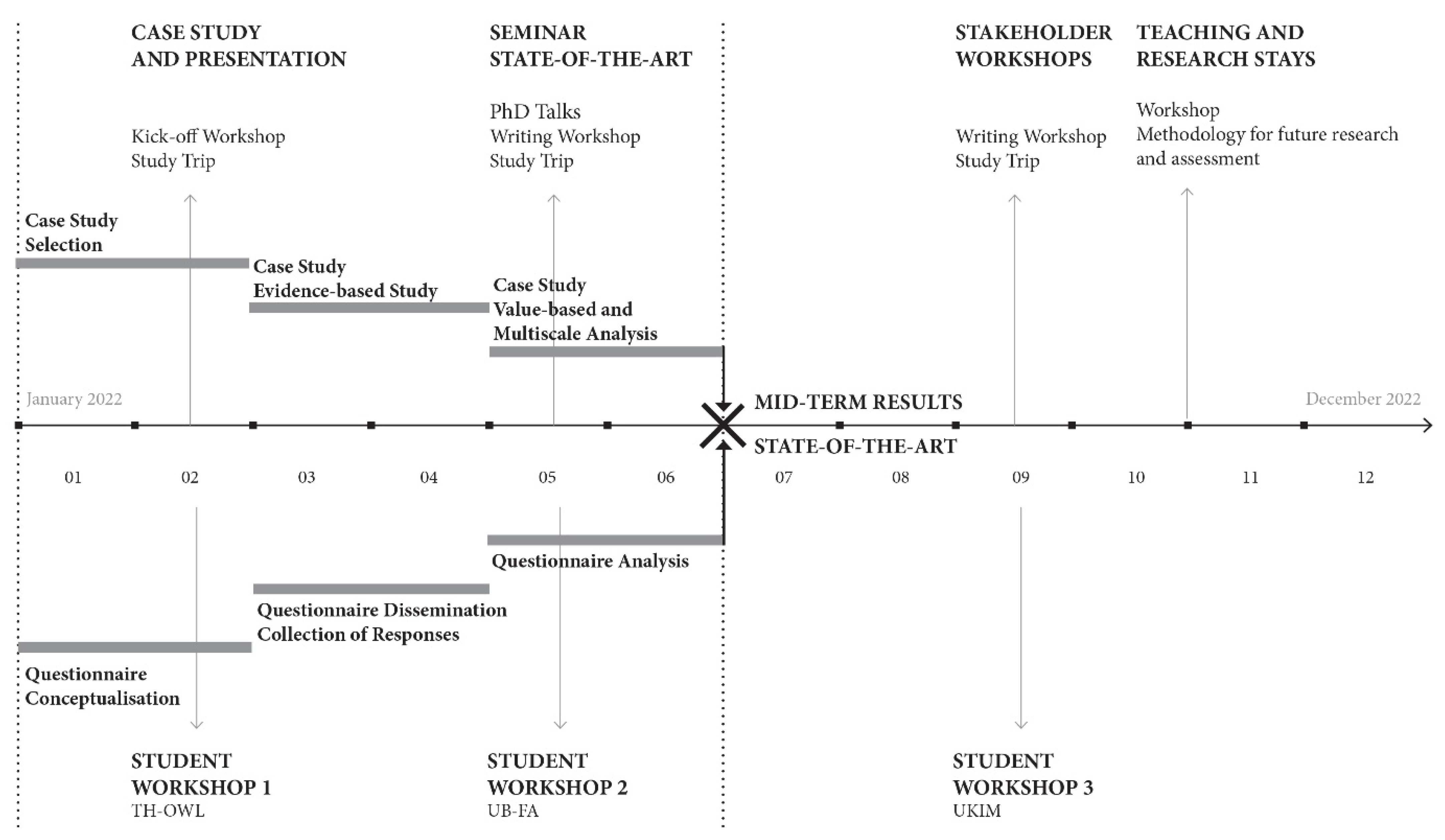
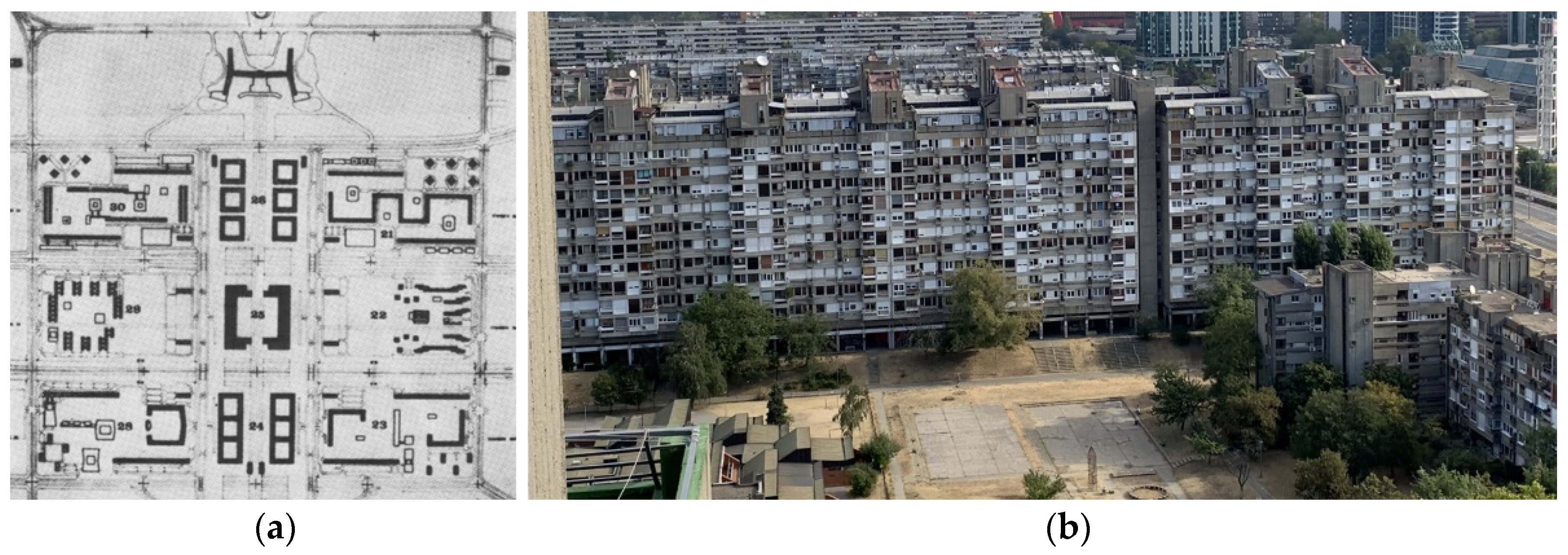
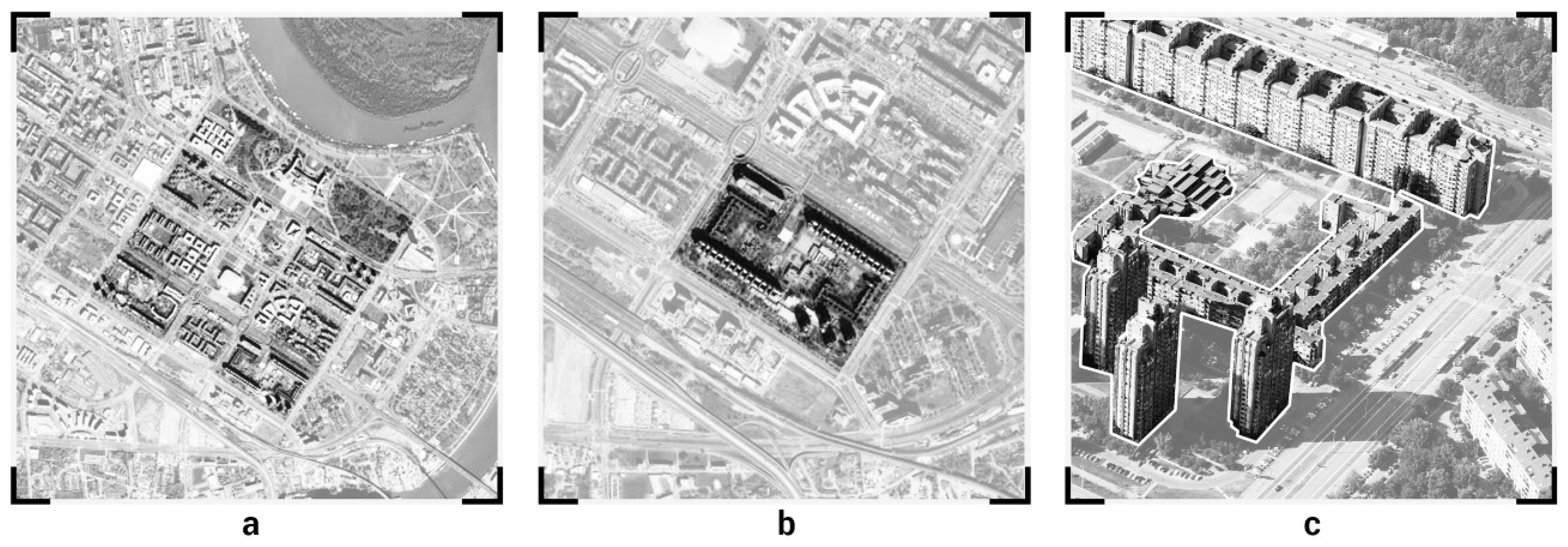
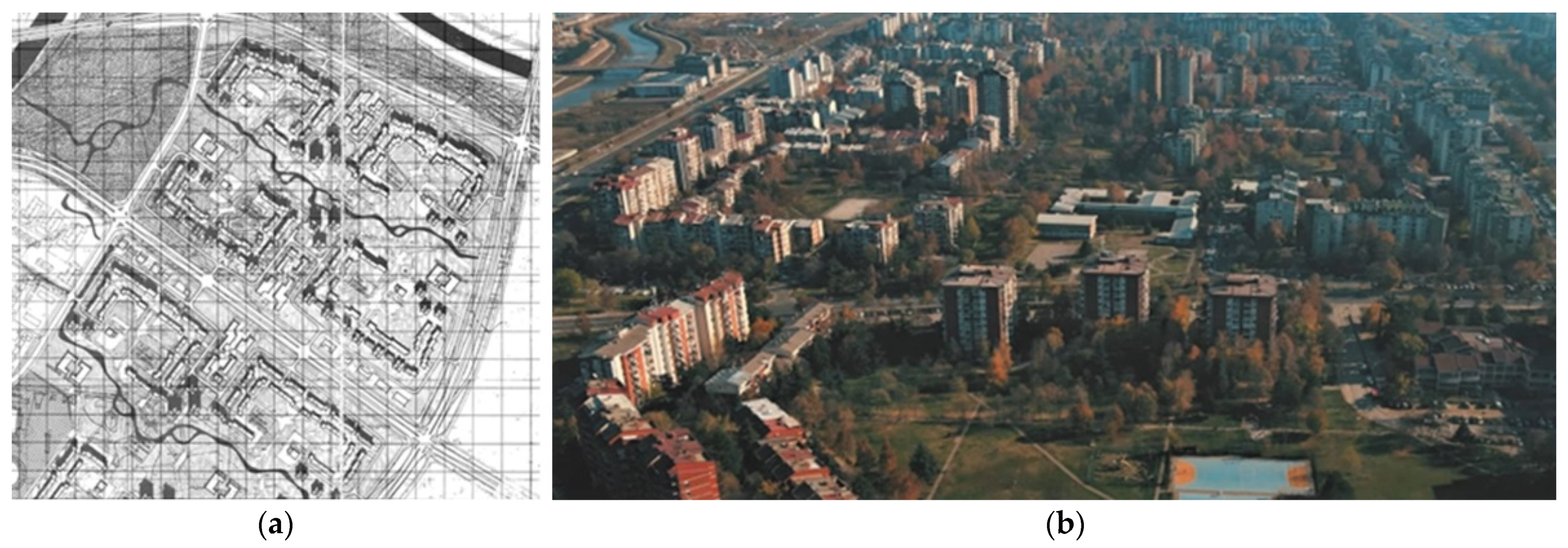
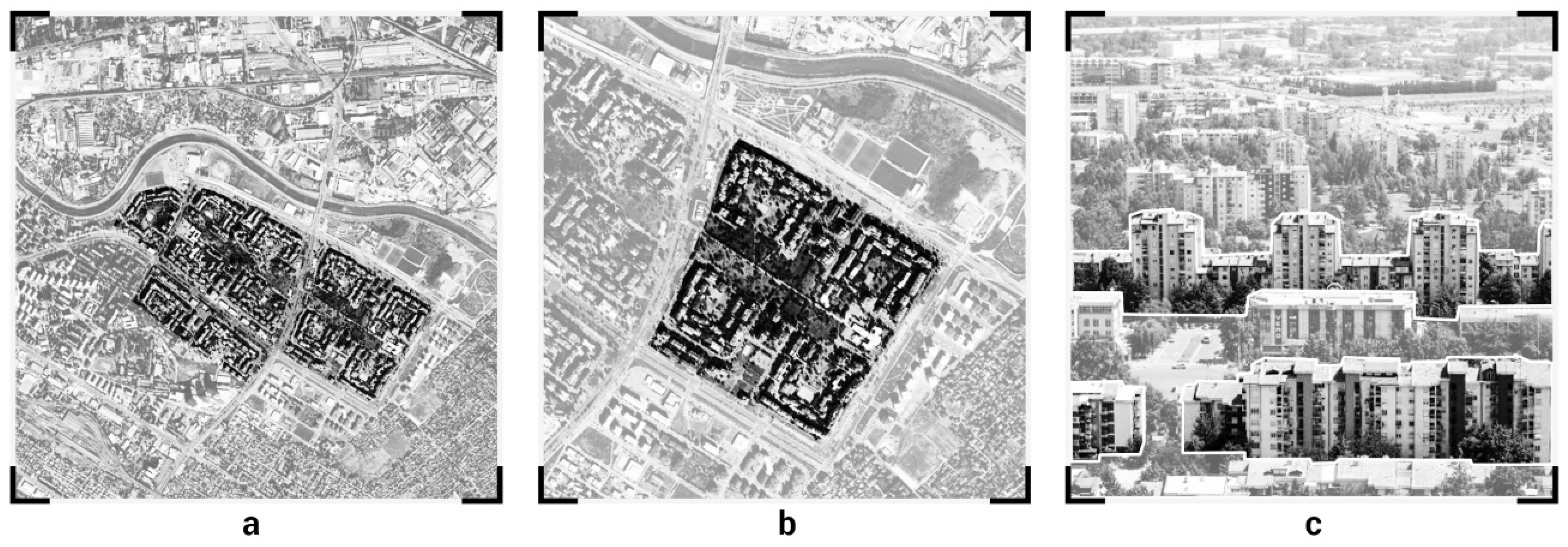

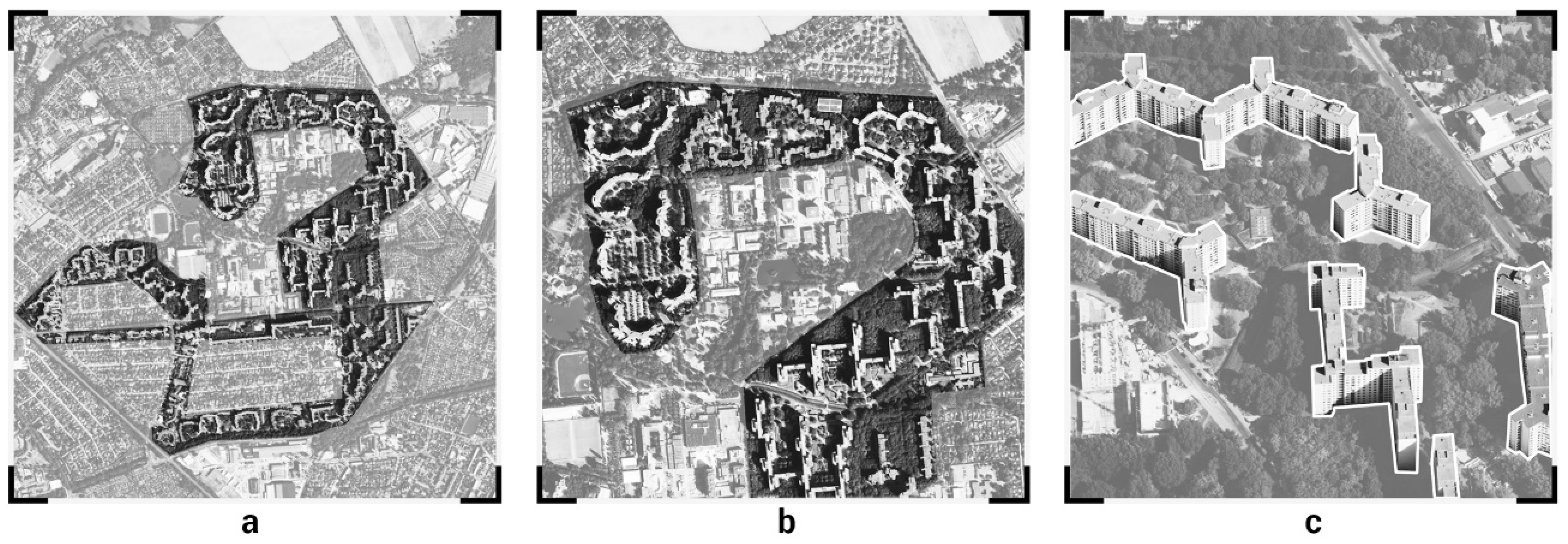
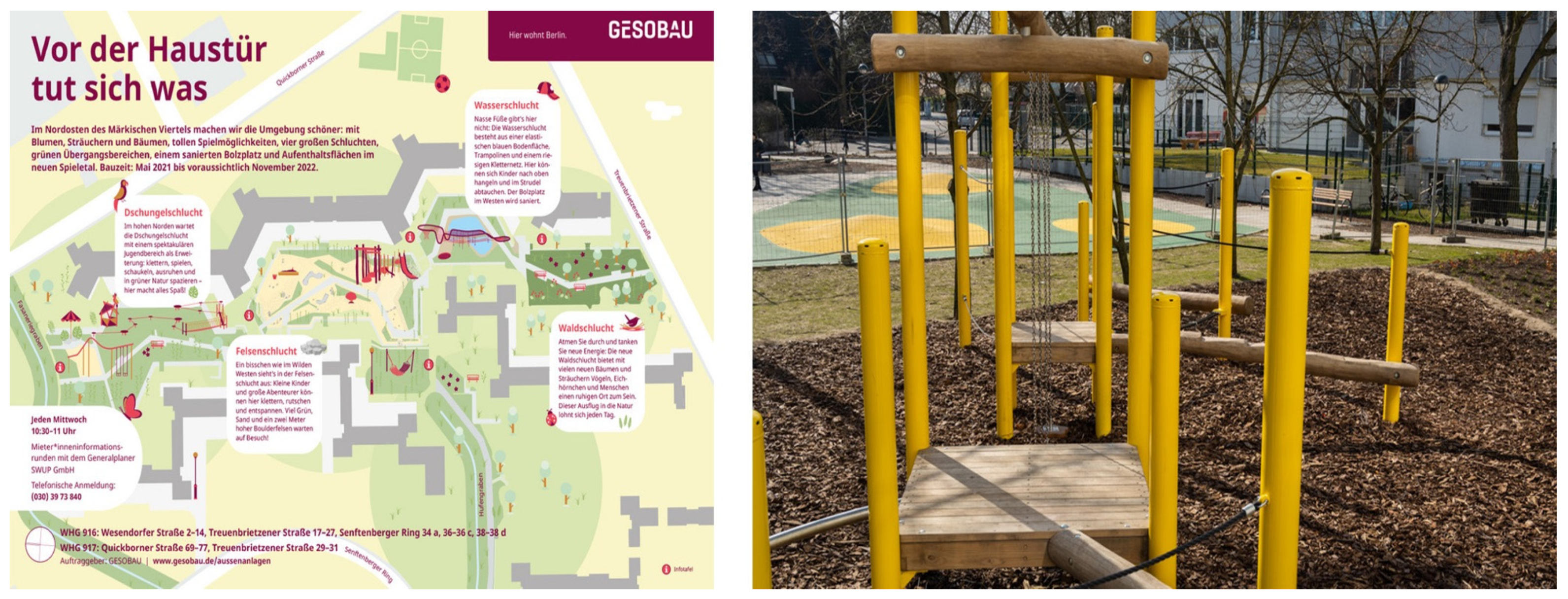
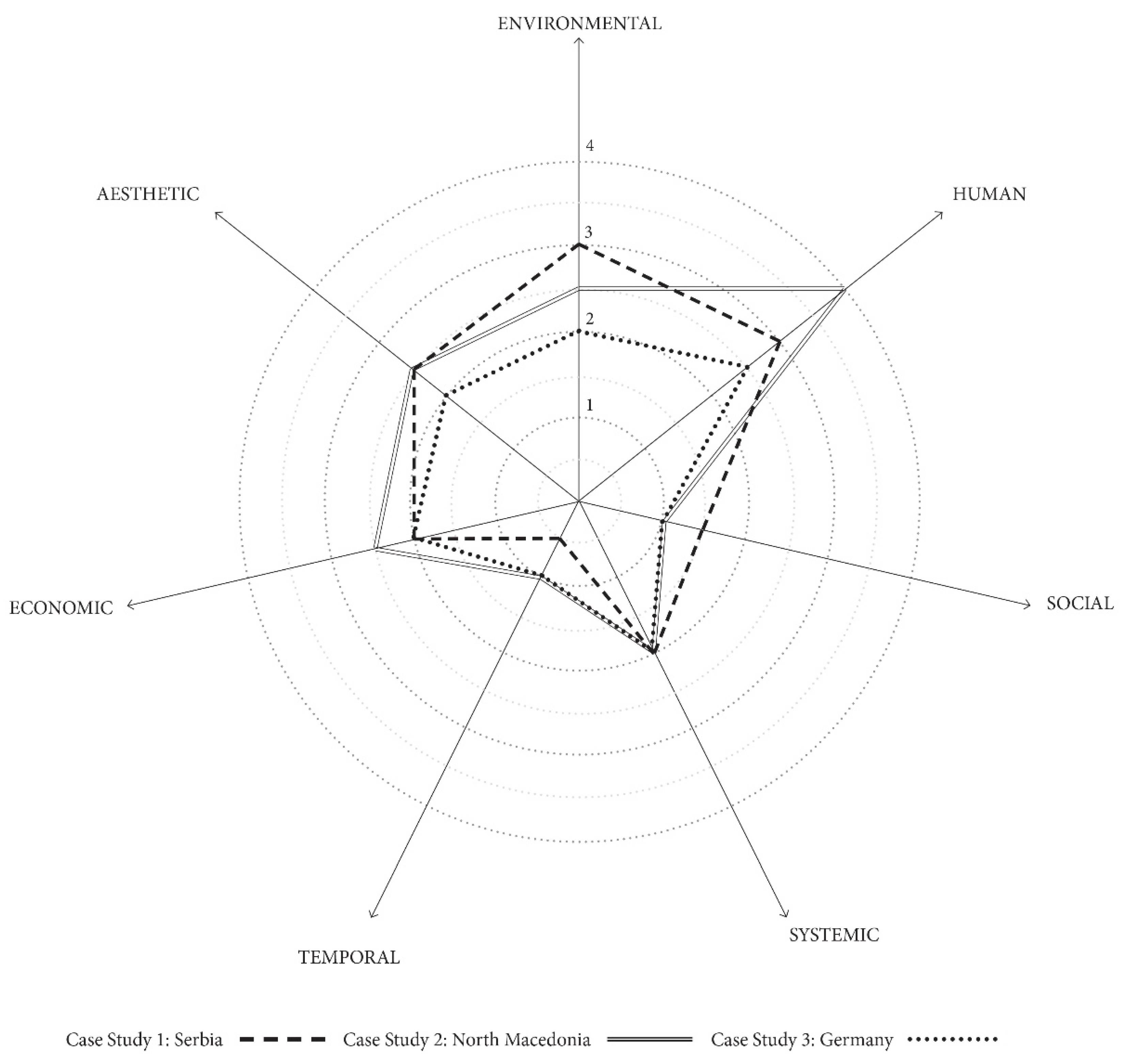
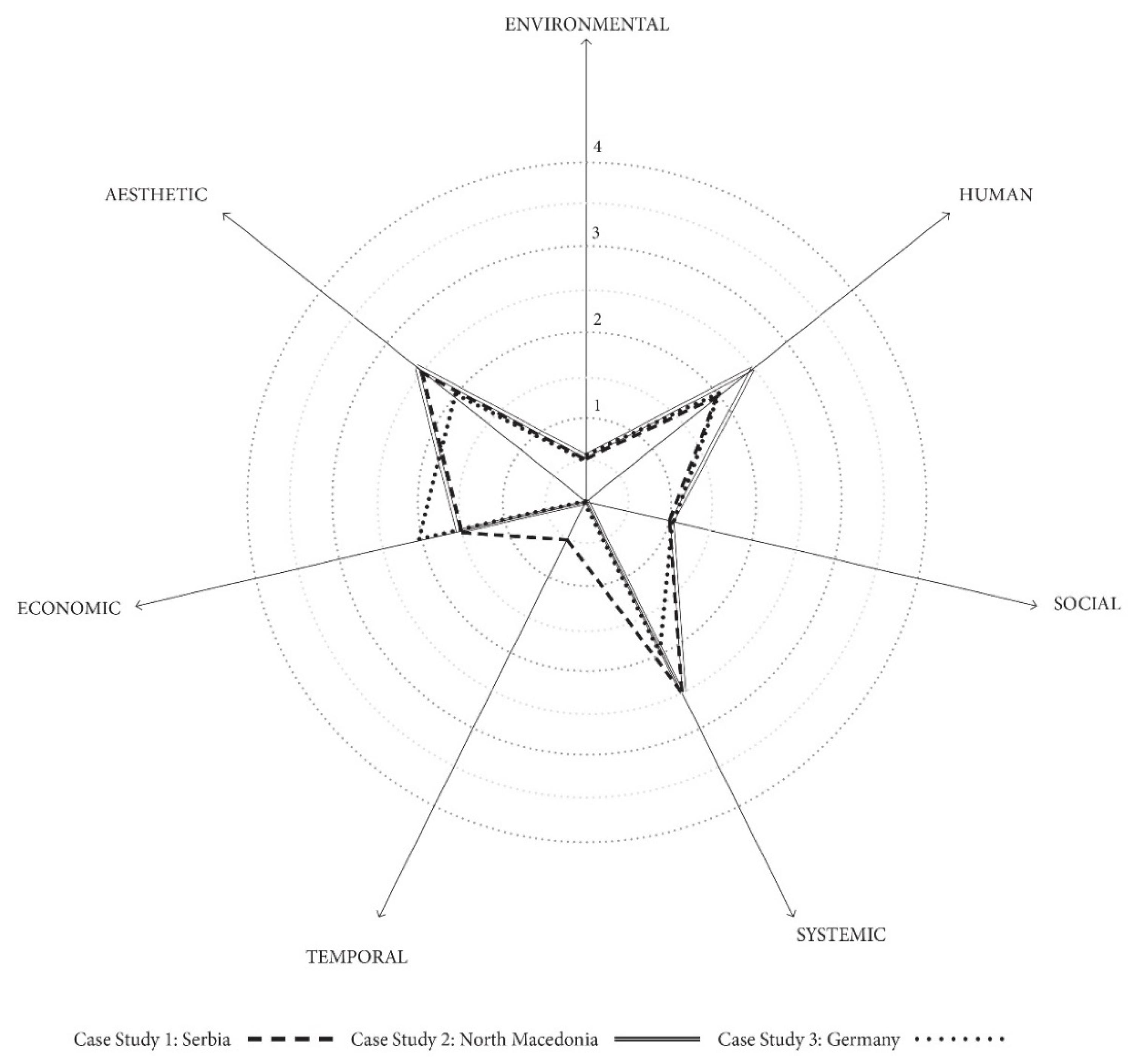
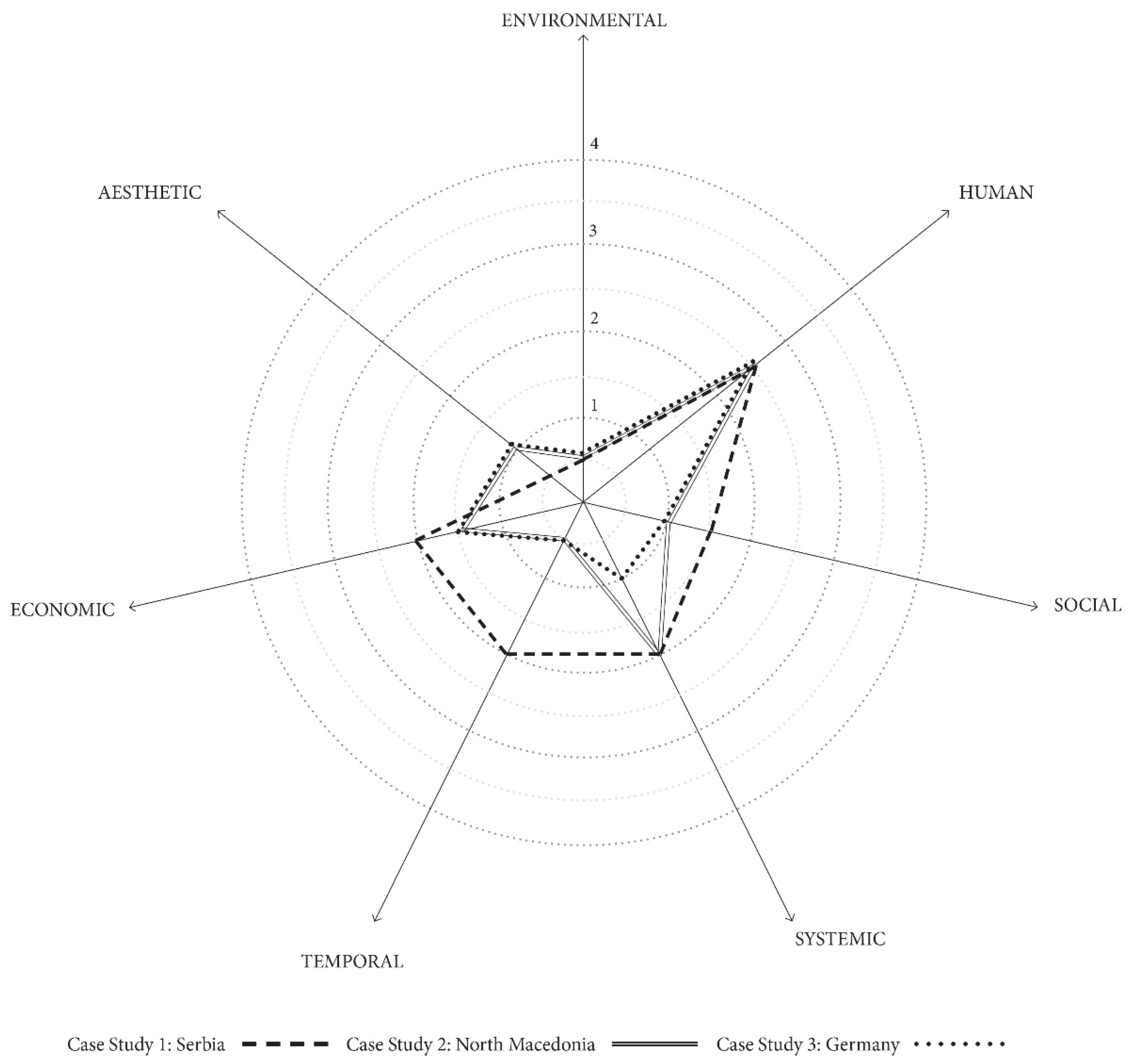
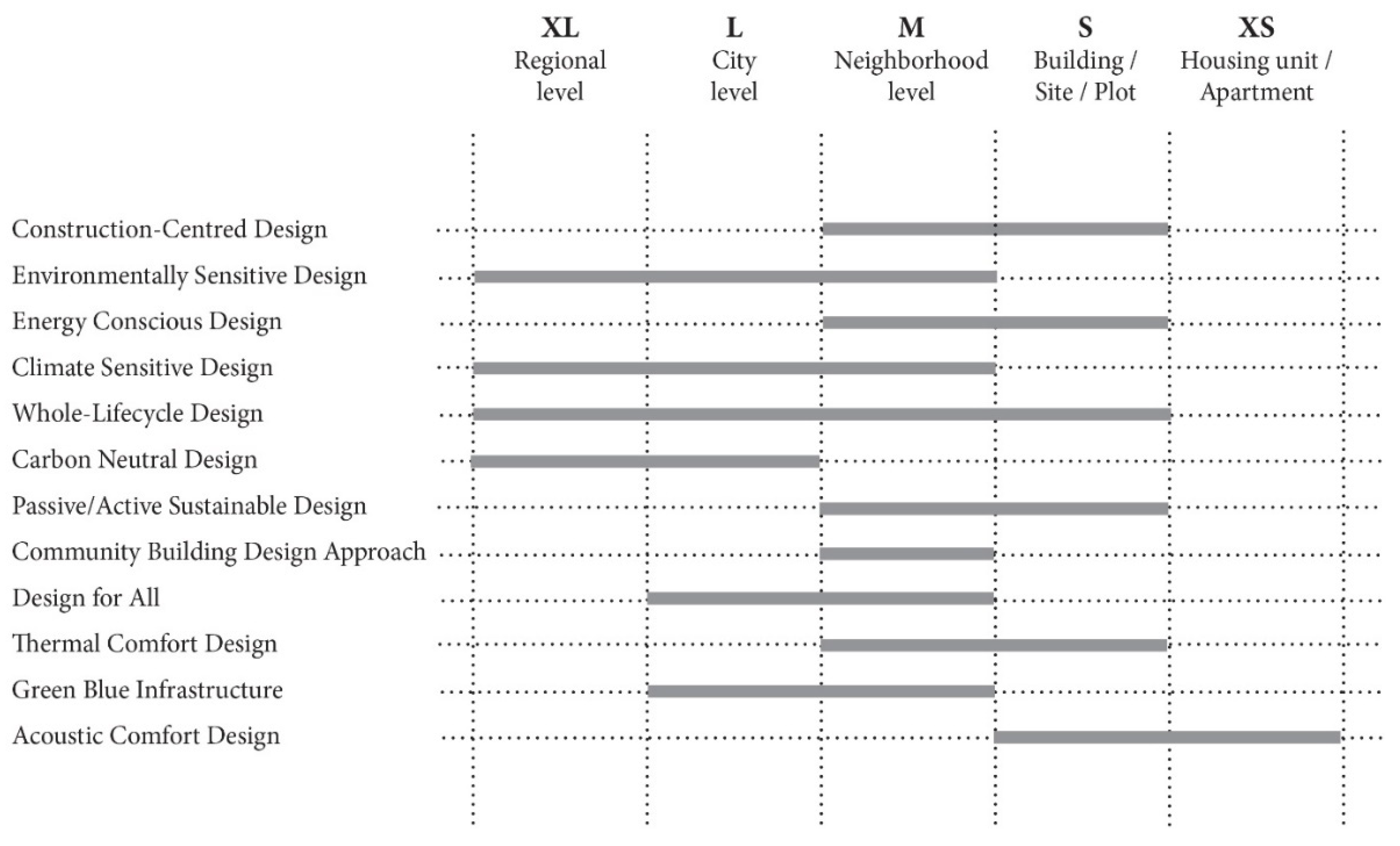
| Values | Environmental | Human | Social | Systemic | Temporal | Economic | Aesthetic |
|---|---|---|---|---|---|---|---|
| Indicators | location climate urban context regional context | physical physiological psychological functional | cultural legal common | materials technologies processes | growth change constancy | building costs operationalisation maintenance | form space style tradition |
| Design Values | Indicators | Case Study 1: Serbia | Case Study 2: North Macedonia | Case Study 3: Germany |
|---|---|---|---|---|
| environmental | climate | + | + | + |
| urban context | • | • | + | |
| regional context | + | X | X | |
| location | • | • | • | |
| human | physical | • | • | + |
| physiological | + | • | + | |
| psychological | + | • | + | |
| functional | • | • | • | |
| social | cultural | X | X | X |
| legal | + | + | + | |
| common | • | + | + | |
| systemic | materials | + | + | + |
| technologies | • | • | • | |
| processes | + | + | + | |
| temporal | growth | X | + | + |
| change | X | X | + | |
| constancy | + | + | X | |
| economic | building costs | • | • | • |
| operationalisation | • | • | + | |
| maintenance | X | + | + | |
| aesthetic | form | • | • | + |
| space | • | • | • | |
| style | + | + | + | |
| tradition | X | X | X |
| Design Values | Indicators | Case Study 1: Serbia | Case Study 2: North Macedonia | Case Study 3: Germany |
|---|---|---|---|---|
| environmental | climate | X | X | X |
| urban context | + | + | + | |
| regional context | X | X | X | |
| location | X | X | X | |
| human | physical | + | + | + |
| physiological | + | + | + | |
| psychological | X | + | X | |
| functional | • | • | • | |
| social | cultural | X | X | X |
| legal | + | + | + | |
| common | + | + | + | |
| systemic | materials | • | • | + |
| technologies | • | • | • | |
| processes | + | + | + | |
| temporal | growth | X | X | X |
| change | X | X | X | |
| constancy | + | X | X | |
| economic | building costs | • | • | • |
| operationalisation | + | + | + | |
| maintenance | X | X | + | |
| aesthetic | form | • | • | • |
| space | • | • | + | |
| style | + | + | + | |
| tradition | X | X | X |
| Design Values | Indicators | Case Study 1: Serbia | Case Study 2: North Macedonia | Case Study 3: Germany |
|---|---|---|---|---|
| environmental | climate | X | X | X |
| urban context | X | X | X | |
| regional context | X | X | X | |
| location | + | + | + | |
| human | physical | + | + | + |
| physiological | + | + | + | |
| psychological | + | + | + | |
| functional | • | • | • | |
| social | cultural | + | + | + |
| legal | • | + | + | |
| common | X | X | X | |
| systemic | materials | + | • | + |
| technologies | • | + | + | |
| processes | + | + | X | |
| temporal | growth | + | X | X |
| change | • | X | + | |
| constancy | + | + | X | |
| economic | building costs | • | • | + |
| operationalisation | • | + | + | |
| maintenance | X | X | + | |
| aesthetic | form | X | + | + |
| space | + | + | + | |
| style | X | X | X | |
| tradition | X | X | X |
Publisher’s Note: MDPI stays neutral with regard to jurisdictional claims in published maps and institutional affiliations. |
© 2022 by the authors. Licensee MDPI, Basel, Switzerland. This article is an open access article distributed under the terms and conditions of the Creative Commons Attribution (CC BY) license (https://creativecommons.org/licenses/by/4.0/).
Share and Cite
Milovanović, A.; Dragutinovic, A.; Nikezić, A.; Pottgiesser, U.; Stojanovski, M.; Ivanovska Deskova, A.; Ivanovski, J.; Damjanovska, T. Rehabilitation of Mass Housing as a Contribution to Social Equality: Insights from the East-West European Academic Dialogue. Sustainability 2022, 14, 8106. https://doi.org/10.3390/su14138106
Milovanović A, Dragutinovic A, Nikezić A, Pottgiesser U, Stojanovski M, Ivanovska Deskova A, Ivanovski J, Damjanovska T. Rehabilitation of Mass Housing as a Contribution to Social Equality: Insights from the East-West European Academic Dialogue. Sustainability. 2022; 14(13):8106. https://doi.org/10.3390/su14138106
Chicago/Turabian StyleMilovanović, Aleksandra, Anica Dragutinovic, Ana Nikezić, Uta Pottgiesser, Mihajlo Stojanovski, Ana Ivanovska Deskova, Jovan Ivanovski, and Tea Damjanovska. 2022. "Rehabilitation of Mass Housing as a Contribution to Social Equality: Insights from the East-West European Academic Dialogue" Sustainability 14, no. 13: 8106. https://doi.org/10.3390/su14138106
APA StyleMilovanović, A., Dragutinovic, A., Nikezić, A., Pottgiesser, U., Stojanovski, M., Ivanovska Deskova, A., Ivanovski, J., & Damjanovska, T. (2022). Rehabilitation of Mass Housing as a Contribution to Social Equality: Insights from the East-West European Academic Dialogue. Sustainability, 14(13), 8106. https://doi.org/10.3390/su14138106








